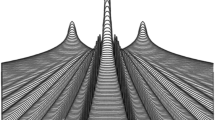Abstract
Afshar et al. claim that their experiment shows a violation of the complementarity inequality. In this work, we study their claim using a modified Mach-Zehnder setup that represents a simpler version of the Afshar experiment. We find that our results are consistent with Afshar et al. experimental findings. However, we show that within standard quantum mechanics the results of the Afshar experiment do not lead to a violation of the complementarity inequality. We show that their claim originates from a particular technique they use to analyze their results. In their analysis, they assume a classical concept, that particles have a definite trajectory before detection, thus, they obtain which-way information by particle detection plus path extrapolation by applying momentum conservation. This analysis technique is standard in experimental particle physics. Important discoveries such as the detection of vector bosons have been made through the application of this technique. We note that particle detection plus path extrapolation is a suitable technique within de Broglie-Bohm theory of quantum mechanics.
Similar content being viewed by others
References
Greenberger, D., Yasin, A.: Simultaneous wave and particle knowledge in a neutron interferometer. Phys. Lett. A 128, 391 (1988)
Englert, B.-G.: Fringe visibility and which-way information: an inequality. Phys. Rev. Lett. 77, 2154 (1996)
Afshar, S.S.: Sharp complementary wave and particle behaviours in the same Welcher weg experiment. Proc. SPIE 5866, 229–244 (2005)
Afshar, S.S., Flores, E., McDonald, K.F., Knoesel, E.: Paradox in wave-particle duality for non-perturbative measurements. Found. Phys. 37, 295 (2007)
Jacques, V., Lai, N.D., Dréau, A., Zheng, D., Chauvat, D., Treussart, F., Grangier, P., Roch, J.-F.: Illustration of quantum complementarity using single photons interfering on a grating. New J. Phys. 10, 123009 (2008)
Steuernagel, O.: Afshar’s experiment does not show a violation of complementarity. Found. Phys. 37(37), 1370–1385 (2007)
Kastner, R.E.: Why the Afshar experiment does not refute complementarity. Stud. Hist. Philos. Mod. Phys. 36, 649–658 (2005)
Kastner, R.E.: On visibility in the Afshar two-slit experiment. Found. Phys. 39, 1139 (2009)
Buonpastore, R., Knoesel, E., Flores, E.: Diffraction of coherent light with sinusoidal amplitude by a thin-slit grid. Opt. Int. J. Light Electron. Opt. (2009). doi:10.1016/j.ijleo.2008.12.004
Fernow, R.: Introduction to Experimental Particle Physics. Cambridge University Press, Cambridge (1989)
Flores, E.: Reply to comments of Steuernagel on the Afshar’s experiment. Found. Phys. 38, 778–781 (2008)
Durr, D., Goldstein, S., Tumulka, R., Zangh, N.: Bohmian mechanics. In: Greenberger, D., Hentschel, K., Weinert, F. (eds.) Compendium of Quantum Physics: Concepts, Experiments, History and Philosophy. Springer, Berlin (2009)
Flores, E., Knoesel, E.: Why Kastner analysis does not apply to a modified Afshar experiment. Proc. SPIE 6664, 66640O (2007)
Flores, E.: Modified Afshar experiment: calculations. Proc. SPIE 7421, 74210W (2009) arXiv:0803.2192v2
Hecht, E., Zajac, A.: Optics. Addison-Wesley, Reading (1974)
Wootters, W.K., Zurek, W.H.: Complementarity in the double-slit experiment: quantum nonseparability and a quantitative statement of Bohr’s principle. Phys. Rev. D 19, 473 (1979)
Kolar, M., Opatrny, T., Bar-Gill, N., Erez, N., Kurizki, G.: Path–phase duality with intraparticle translational–internal entanglement. New J. Phys. 9, 129 (2007)
Wheeler, J.A.: Law Without Law, Quantum Theory and Measurement. Princeton University Press, Princeton (1983)
Jacques, V., Wu, E., Grosshans, F., Treussart, F., Grangier, P., Aspect, A., Roch, J.-F.: Delayed-choice test of quantum complementarity with interfering single photons. Phys. Rev. Lett. 100, 220402 (2008)
Eisberg, R., Resnick, R.: Quantum Physics of Atoms, Molecules, Solids, Nuclei, and Particles. Wiley, New York (1985)
Dürr, S., Rempe, G.: Can wave–particle duality be based on the uncertainty relation? Am. J. Phys. 68, 1021 (2000)
Author information
Authors and Affiliations
Corresponding author
Rights and permissions
About this article
Cite this article
Flores, E.V., De Tata, J.M. Complementarity Paradox Solved: Surprising Consequences. Found Phys 40, 1731–1743 (2010). https://doi.org/10.1007/s10701-010-9477-4
Received:
Accepted:
Published:
Issue Date:
DOI: https://doi.org/10.1007/s10701-010-9477-4




